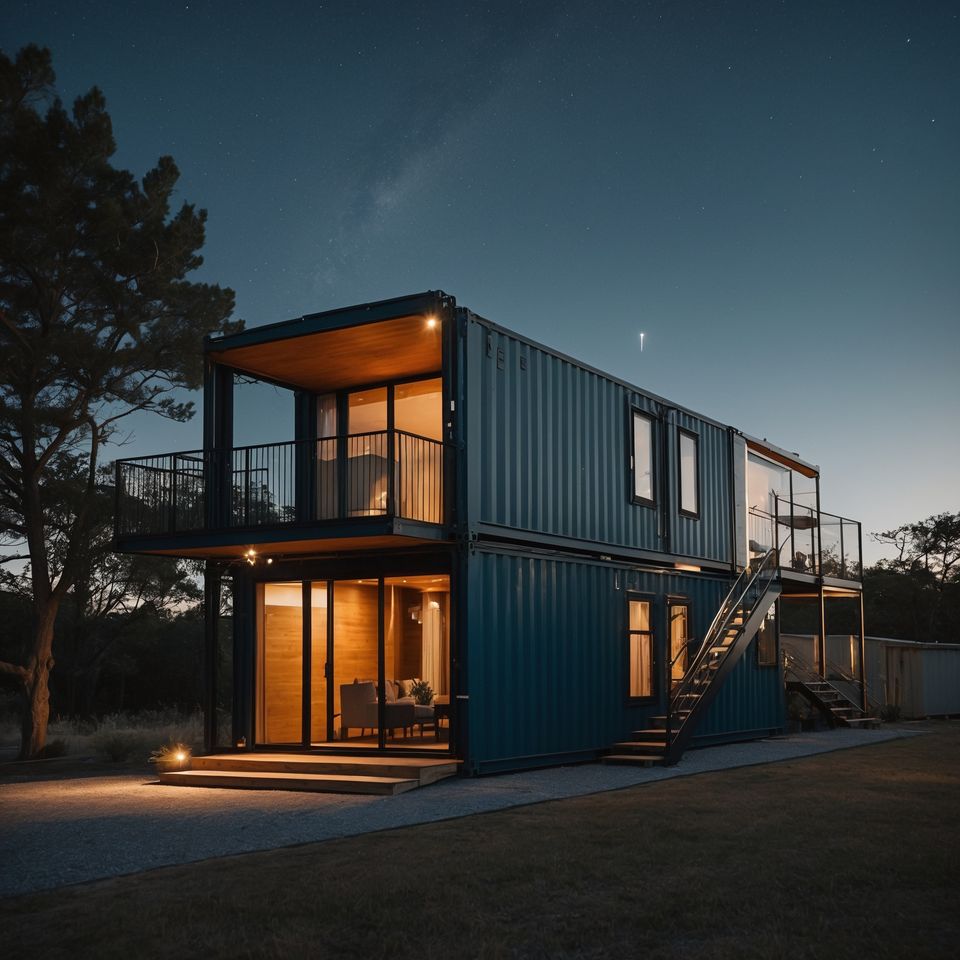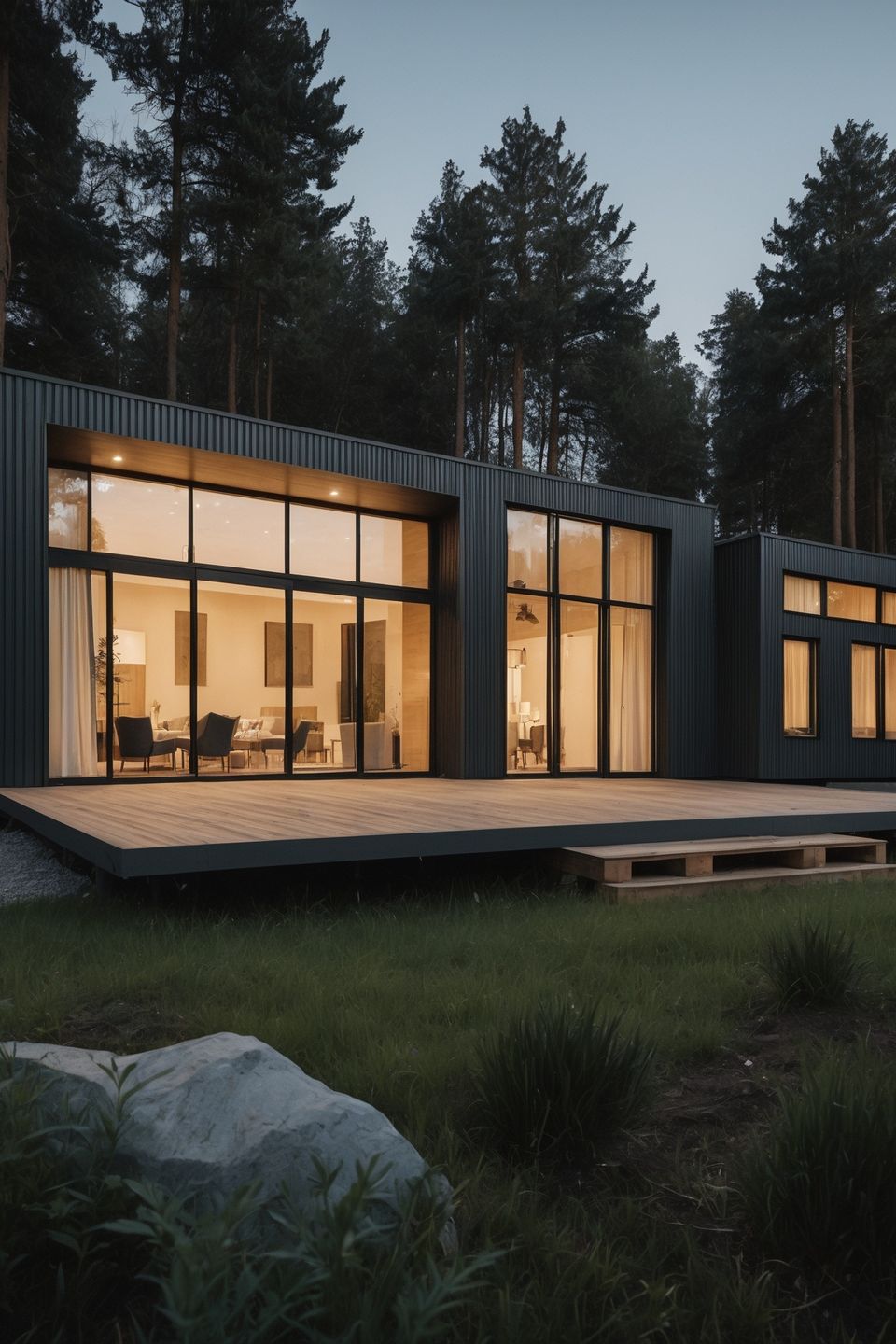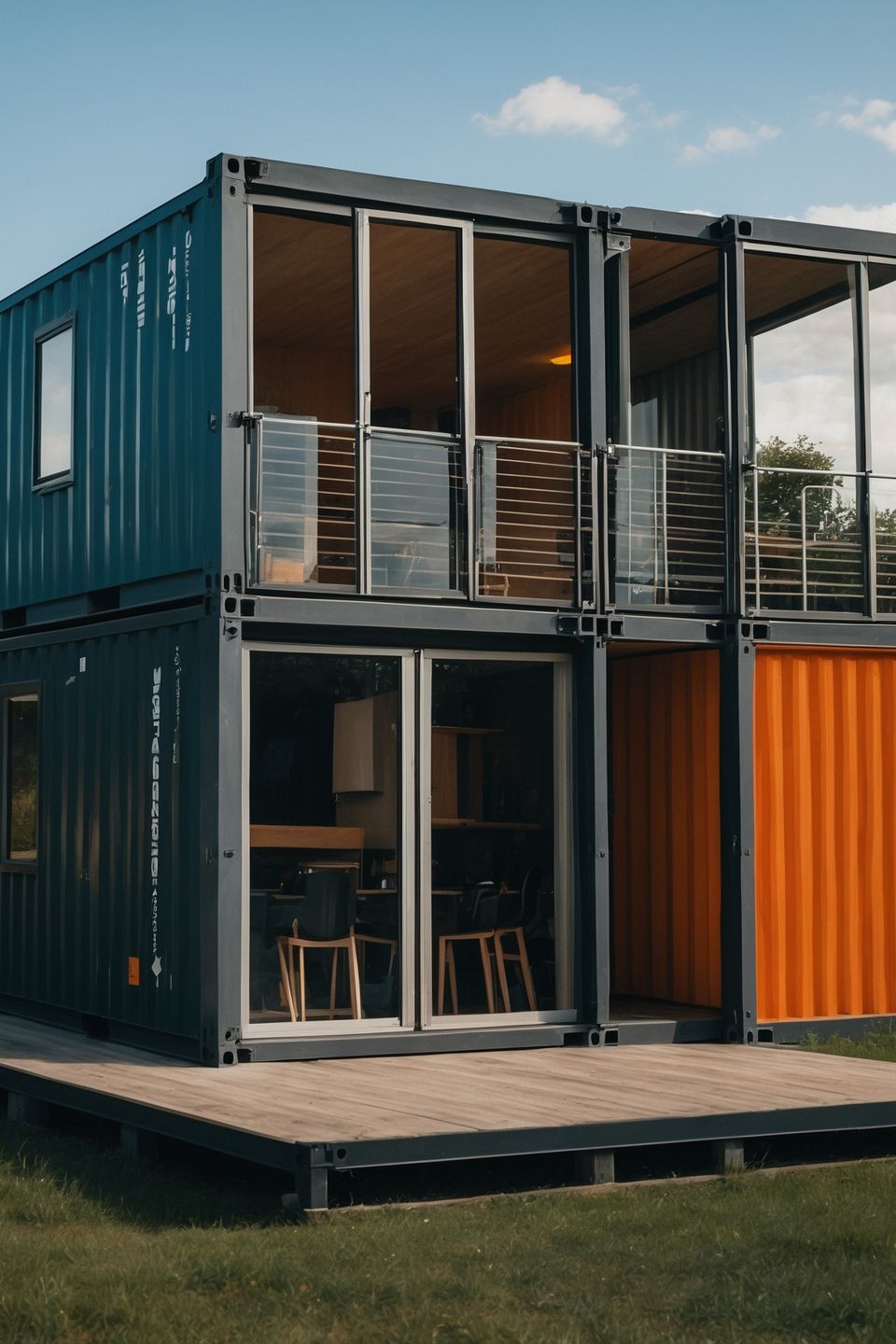Shipping Container Tiny Homes
Disclaimer: Content Features Links That Pay Us Commissions at No Extra Cost to You

Why a Shipping Container
Is Perfect For Homeowners
In the quest for sustainable living solutions, shipping container tiny homes have emerged as a compelling option. Originally used for transporting goods across oceans, shipping containers have been repurposed into stylish, durable, and eco-friendly homes that offer a twist on traditional housing.
What Are Shipping Container Tiny Homes?
Shipping container tiny homes are exactly what they sound like - homes made from new or used shipping containers that have been modified to be livable spaces. Typically measuring either 20 or 40 feet in length, these containers are transformed through cutting windows, doors, and adding insulation, plumbing, and electrical systems to create compact, efficient residences.
Why Choose a Shipping Container Home?
The appeal of shipping container homes lies in their simplicity and versatility. They can be set up almost anywhere, from remote countryside plots to urban rooftops, and their robust structure makes them particularly suited to environments that challenge traditional building methods. Additionally, their modular nature allows for creative design and stacking possibilities, making them a popular choice among modern architects and eco-conscious builders.
A Sustainable Choice
Shipping container homes represent a step towards sustainable living. By repurposing used containers, these homes reduce demand for new construction materials, aligning with an environmentally friendly approach to building. Their adaptability enhances their sustainability, appealing to those looking to minimize their ecological footprint.
An Affordable Housing Solution
Shipping container tiny homes are more affordable than conventional homes. Their compact size and construction efficiency significantly lowers costs, providing an accessible entry point into homeownership.
As the tiny home movement grows, shipping container homes stand out for their strength and simplicity. Whether you are a minimalist seeking a streamlined space or an innovator looking to design a dwelling, shipping containers offer a unique foundation to build your dream home.
Shipping Container Tiny Homes Are
Long-Term Cost-Effective Solutions

Benefits of
Shipping Container Homes
Shipping container tiny homes are an attractive option for individuals and families looking for an alternative living solution. Here are some of the key benefits
Durability and Security
Shipping containers are designed to withstand harsh conditions during ocean transport, which makes them very durable for housing. Their steel construction provides robust protection against extreme weather, fire, and pests, ensuring a secure living environment.
Cost-Effective
One of the most appealing aspects of shipping container homes is their cost-effectiveness. The initial purchase price of a shipping container is lower than the cost of traditional building materials. The conversion process is less expensive than building a home from scratch, especially if you opt for minimalistic designs and DIY modifications.
Eco-Friendly
Shipping container homes help reduce waste by repurposing materials that might otherwise contribute to landfills. Their compact size requires less energy for heating and cooling, further enhancing their sustainability. Many owners choose to integrate solar panels, rainwater collection systems, and other green technologies to boost their eco-friendliness.
Easy to Construct
Unlike traditional homes that can take several months to build, shipping container homes can be converted in a fraction of the time. This is due to the prefabricated nature of the containers which already have a set structure, that can be quickly modified with tools and planning.
Mobility
While shipping container homes can be placed permanently on a foundation, they also offer the unique benefit of mobility. Containers can be designed to remain movable, providing flexibility for homeowners who might consider relocating their home in the future.
Customizable
Shipping container homes provide a blank canvas that can be tailored to suit individual needs. Whether you want an industrial look or a traditional feel, containers can be cut, styled, and finished in countless ways. Multiple containers can be combined to increase space, and creative layouts can be configured to maximize functionality.
Space Efficiency
The compact design of shipping container homes encourages efficient use of space, for a minimalist lifestyle that is trendy and practical. This efficiency makes them perfect for singles, couples, or small families who want to live comfortably without the burden of maintaining a large space.
55% of Tiny House Owners Have More
Savings Than the Average American

Shipping Containers
Sustainability and Eco-Friendliness
Shipping containers are at the forefront of sustainable housing solutions, offering environmentally conscious individuals a way to minimize their ecological footprint.
Here is why these structures promote sustainability and eco-friendliness
Reuse and Recycle
These homes repurpose used shipping containers that might otherwise end up unused or discarded. By converting them into functional homes, we use existing materials and reduce the amount of waste sent to landfills. This reuse aligns with the principles of sustainable living, emphasizing the repurposing of limited resources.
Energy Efficiency
Shipping container homes are smaller than traditional houses, which inherently requires less energy for heating, cooling, and lighting. This reduced energy consumption is crucial for decreasing one’s carbon footprint. Shipping containers can be outfitted with insulation and weatherproofing that meet or exceed energy efficiency standards, reducing excessive energy use.
Integration with Green Technologies
Many builders and homeowners choose to equip their shipping container homes with sustainable technologies. Solar panels, rainwater harvesting systems, and greywater systems are common additions that enhance sustainability. These technologies help homeowners achieve self-sufficiency, reduce reliance on non-renewable resources, and have a sustainable lifestyle.
Low Impact Construction
The construction process for a shipping container home is significantly less than traditional home building. The major components already exist, minimizing the need for new materials. Additionally, the off-site preparation of these homes can preserve the natural environment of the building site.
Longevity and Durability
Constructed from high-quality steel, shipping containers are designed to withstand harsh conditions and provide secure transportation over oceans. This durability translates into long-lasting homes that require fewer repairs and maintenance.
Compact Living
The tiny home movement encourages people to downsize and live only with what they need. Shipping container homes support this philosophy perfectly, promoting a lifestyle that reduces consumption of goods and energy, for simpler sustainable living.
These elements make shipping container tiny homes a statement of sustainable living, offering a practical solution for those looking to reduce their environmental impact while enjoying a modern and efficient home.
68% of Tiny House Owners Don't Have a Mortgage
Compared to 29% of All U.S. Homeowners

Shipping Containers
Maintenance and Upkeep
Shipping container tiny homes are celebrated for their uniqueness and sustainability as well as their ease of maintenance. Here are some points regarding upkeep
Corrosion Resistance
One of the primary concerns with shipping container homes is the potential for rust and corrosion, given their steel construction. To mitigate this, it is essential that the containers are properly treated with rust-proof coatings and paints. Regular inspections should be conducted to ensure the integrity of these protective layers, and touch-ups should be applied as needed to prevent corrosion.
Insulation and Condensation Control
Proper insulation is crucial to prevent condensation, which can lead to moisture problems inside the home. It is important to check the insulation regularly for any signs of damage or degradation. Ensuring that vapor barriers are intact and effective can prevent maintenance issues related to moisture.
Roof Maintenance
The roof of a shipping container home typically requires minimal upkeep. It is advisable to inspect the roof periodically, especially after extreme weather conditions, to ensure there are no leaks or structural damages. Keeping the roof clean from debris and water accumulation can prevent issues and extend its lifespan.
Sealant and Joint Checks
Sealants used in the construction of shipping container homes can wear out, especially around windows, doors, and joining points of multiple containers. Regular checks and resealing can prevent air and water leaks, which are crucial for maintaining the thermal efficiency and dryness of the home.
Paint and Aesthetic Upkeep
The exterior paint of a shipping container home serves as an additional layer of protection against the elements. To keep your home looking fresh and to maintain its protective qualities, plan for periodic repainting or touch-ups, especially in areas that are exposed to harsh weather.
Interior Maintenance
Inside the shipping container home, maintenance tends to be easier than traditional houses due to the smaller spaces. Regular cleaning and checking of appliances and fixtures to ensure they are in good working condition will suffice for most interior maintenance needs.
Pest Control
While shipping container homes are less prone to pest invasions than wood-framed structures, it is still important to monitor for signs of pests, especially if the home is located in a pest-prone area. Regular inspections and treatments can prevent any infestations from becoming serious problems.
Overall, the maintenance of a shipping container tiny home is straightforward and manageable. With regular checks and basic care, these homes can provide a durable, comfortable, and sustainable living environment for many years.
Shipping Container Homes Are Ideal Year-Round
Even in Harsh Winter Cold or Intense Summer Heat

Design and Customization
Shipping Container Tiny Homes
Shipping container tiny homes offer a versatile canvas for creative expression. Their inherent structural simplicity makes them ideal for a wide range of design adaptations, from minimalist modern aesthetics to more complex, multi-container configurations.
Exterior Modifications
One of the most common customizations involves adding windows and doors to bring in natural light and improve airflow. Options range from full-length sliding glass doors to stylishly framed windows, each enhancing the container’s functionality while maintaining its industrial charm.
To change the industrial look, owners can add wood, stone, or modern composite materials as cladding. This not only transforms the appearance but can also provide additional insulation.
Interior Layouts
The interior of a shipping container can be designed as a single open-plan space or divided into separate rooms using lightweight partitions. This flexibility allows for a variety of layouts, accommodating anything from a cozy studio design to a more traditional home with distinct living areas.
For containers stacked vertically, a loft or mezzanine can be a smart way to utilize the vertical space, providing extra room for sleeping or storage.
Functional Add-ons
Custom furniture that folds away or serves multiple functions can significantly enhance the usability of the limited space. Built-in benches, pull-down beds, and convertible tables are popular choices.
Integrating smart home technology, such as automated lighting, heating, and security systems, can maximize convenience and efficiency in a tiny living space.
Multi-Container Configurations
Shipping containers can be stacked or joined side by side to create larger, more complex home designs. This modularity allows homeowners to start with a single container and expand their space as needs and budgets grow.
Containers do not just have to be aligned in traditional grids, they can be set at angles or offset to create interesting architectural features and outdoor spaces like terraces or covered porches.
Eco-Friendly Elements
A green roof helps with insulation and reducing rainwater runoff. This can be particularly effective in urban settings.
Adding solar panels and systems for collecting rainwater can make a shipping container home nearly self-sufficient, which is ideal for remote locations or for homeowners trying to minimize their environmental impact.
With these customization options, shipping container tiny homes can be tailored to reflect individual preferences and functional needs, making them a popular choice for home owners who want a customized sustainable living solution.
